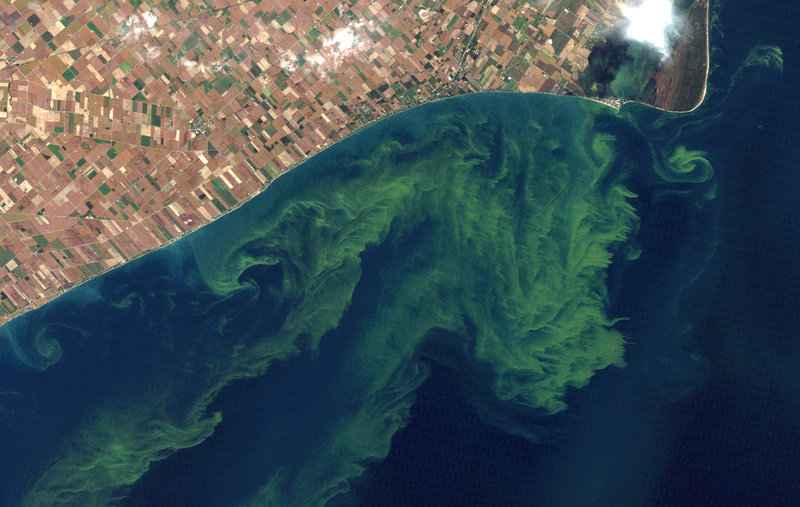TRAVERSE CITY, Mich. — It was the largest algae bloom in Lake Erie’s recorded history – a scummy, toxic blob that oozed across nearly one-fifth of the lake’s surface during the summer and fall of 2011. It sucked oxygen from the water, clogged boat motors and washed ashore in rotting masses that turned beachgoers’ stomachs.
It was also likely an omen of things to come, experts said in a study released Monday. The warming climate and modern farming practices are creating ideal conditions for gigantic algae formations on Lake Erie, which could be potentially disastrous to the surrounding area’s multi-billion-dollar tourist economy. The shallowest and southernmost of the Great Lakes, Erie contains just 2 percent of the Great Lakes’ combined waters but about half their fish.
According to the report, which was compiled by more than two dozen scientists, the 2011 runaway bloom was fueled by phosphorus-laden fertilizers that were swept from corn and soybean fields during heavy rainstorms. Weak currents and calm winds prevented churning and flushing that could have short-circuited its rampant growth.
The combination of natural and man-made circumstances “is unfortunately consistent with ongoing trends, which means that more huge algal blooms can be expected in the future unless a scientifically guided management plan is implemented for the region,” said the report’s lead author, Anna Michalak, of the Carnegie Institution for Science.
The blooms consist largely of blue-green strains that are poisonous and cause skin irritation. Measurements in 2011 found concentrations of a liver toxin they produce were hundreds of times higher than levels approved by the World Health Organization for drinking and recreational waters.
The building blocks of algae blooms, particularly phosphorus, are well known. The newly released paper was compiled by experts from a range of disciplines to determine why the 2011 bloom got so huge and whether it’s a harbinger of things to come. At its peak, that bloom covered 1,930 square miles, making it more than twice as big as the freshwater sea’s second-biggest bloom on record, which happened three years earlier.
Published in the online version of Proceedings of the National Academy of Sciences, the report said soil management practices in the region’s corn and soybean fields are partly to blame.
One such practice is no-till farming, in which seeds are planted in small holes and the ground is not plowed. While it helps the environment by preventing erosion, no-till farming keeps fertilizer in the upper soil. Other culprits include the application of fertilizer in the fall, when the ground is bare, and the spreading of manure on the surface, instead of into the soil. Together, they leave huge volumes of phosphorus where it can be easily washed into streams and eventually, into Lake Erie.
That’s what happened in the spring of 2011, when the area was slammed by heavy storms.
The bloom formed that July around the mouth of the Maumee River, on the lake’s western end near Toledo, Ohio. Under normal circumstances, choppy waters might have diluted the phosphorus and broken up the bloom. Instead, a calm spell enabled it to keep growing.
By October, it had moved past Cleveland – more than 100 miles to the east – and penetrated the lake’s central basin, where decomposed algae had already created an oxygen-deprived “dead zone” lethal to most fish and other aquatic organisms.
Scientists are studying how the algae outbreak might have affected fish populations but have reached no firm conclusions, said Jeff Tyson, Lake Erie program administrator with the Ohio Department of Natural Resources. Numbers of the lake’s most prized sport and commercial species, walleye and yellow perch, have dipped in recent years in the fertile western basin. But because so many factors affect them, it’s uncertain what role – if any – the algae has played.
The lake’s algae cover was about 90 percent smaller during drought-stricken 2012. But the scientists analyzed computer models and concluded that as the planet warms over the next century, weather that fueled the 2011 mega-bloom may become “the new normal,” Michalak said. The report noted storms generating more than an inch of rain could happen twice as often, and wind speeds are dropping.
Slowing climate change would require action on a global scale. But significant cuts in Lake Erie’s phosphorus levels could be achieved with different fertilizing techniques, the scientists said.
“A lot of management practices that were put in place in the ’80s improved things for a while, but we’re shifting into this warmer world and we need new practices,” said Allison Steiner, a University of Michigan atmospheric scientist and member of the study team.
Send questions/comments to the editors.



Success. Please wait for the page to reload. If the page does not reload within 5 seconds, please refresh the page.
Enter your email and password to access comments.
Hi, to comment on stories you must . This profile is in addition to your subscription and website login.
Already have a commenting profile? .
Invalid username/password.
Please check your email to confirm and complete your registration.
Only subscribers are eligible to post comments. Please subscribe or login first for digital access. Here’s why.
Use the form below to reset your password. When you've submitted your account email, we will send an email with a reset code.